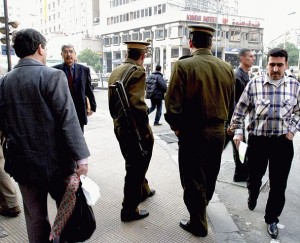
The tide seems to be turning in Syria. While the civil war is far from over, the regime is clearly weakening; the rebels are expanding their operations and effectiveness. There have also been more high-level defections. What does this mean and why is this happening?
There are three main factors that are making a rebel victory seem more likely.
First, Saudi Arabia and Qatar, with Turkey’s facilitation and U.S. coordination, are sending arms to the opposition.
Second, the regime has been rushing the same trusted units around the country to put down upsurges and these forces are getting tired and stretched thin.
Third, President Bashar al-Assad really has nothing to offer the opposition. He won’t leave and he can’t share power. His strategy of brutal suppression and large-scale killing can neither make the opposition surrender nor wipe it out. Even if he kills civilians and demonstrators, the rebel military forces can pull back to attack another day.
Even though the fighting may go on for months, then, it is time to start assessing what outcomes might look like. Here are some suggestions:
-Ethnic massacres? While there have been reports of such actions-the regime killing Sunni Muslims; the opposition killing Alawites and Christians-what we’ve seen already might be nothing compared to what is to come. Such murders might take place during the civil war or after it ends.
-An Alawite fortress? Assad has built up his defenses in northwest Syria where most of the Alawites live to make a last stand or to try to hold out. How would such a final phase in the war go and could Assad keep the rebels from taking this stronghold?
-Obama Administration bragging rights? We’ve already had leaks about U.S. covert involvement in the anti-Assad effort. If the rebels seem to be winning or do in fact win the war before November, the White House will claim Syria as proof of its tough, triumphant foreign policy. (The elections in Libya, in which reportedly the Islamists were held off by a U.S.-backed government, will be cited as another example of success.)
-But at great risk. What if the Obama Administration increasingly claims credit for regime change in Syria and then has to take blame for massacres or an Islamist takeover?
-The Kurdish factor. Syria’s Kurds have essentially walled off their northeast section of the country. Their armed militia, helped by their compatriots in Iraq, can hold out against all but the most concerted force. The Kurds generally view the regime as repressive Arab nationalists while they see the opposition as Islamists and Arab nationalists. Would a new regime in Damascus make a deal with them for autonomy, or would it be tempted to try to conquer the area? If so, how would the opposition’s Western backers react to such an assault?
-And then there’s the biggest question of all: Who among the opposition forces would take power? Syria is quite different from such relatively homogeneous countries as Egypt and Tunisia. Let’s just list the different groupings:
Alawites now rule and in general support the regime. The treatment of the Alawites-who pretend to be Shia Muslims but really aren’t Muslims at all-would be a key indicator for a new regime. Would it seek conciliation or massacre large numbers of them? Unless Assad can hold out in the northwest, the Alawites will have little role in a post-Assad Syria.
Christians also generally support the regime because they fear Islamists taking power. Will they face massacres and flee the country or will the new regime work to accommodate them.
Alawites and Christians together number more than one-fourth of the country’s population.
The Kurds have been discussed above. Their goal is autonomy, one that a new central government could meet but will it want to grant them such status?
The Druze, who live in the southwest of the country, have not played a major role in the rebellion. They tend to accommodate themselves to the status quo. Will they organize communally and seek some autonomy? The Druze strategy is of special interest to Israel since they live closer to the Golan Heights and, indeed, Israel rules a Druze population there most of whose members identify as Syrians. Would a new regime’s treatment of the Druze make the Golan Heights’ residents more rebellious against Israel or more eager to remain under Israeli rule?
And finally there are the Sunni Muslim Arabs who comprise about 60 percent of the population. As a group they would be the new rulers. But they are very much divided among themselves. On one hand there are the Islamists, both Muslim Brotherhood and Salafists; on the other hand there are urban moderates who are more proportionately numerous and politically astute than their Egyptian counterparts. Who will get the upper hand?
Yet even that is an incomplete inventory. In addition, there are many rural Sunni Arabs who could be described as traditionalists, who want a socially conservative state but could swing in either direction politically.
Last and certainly not least are the military officers who deserted Assad’s army and now run much of the opposition Free Syrian Army (FSA). They can be described as both technocrats and as Arab nationalists in varying degrees. Would they impose themselves on a new government?
The exile groups, including the U.S. backed Syrian National Council (SNC) seem to have little influence and prestige within the country. Would the Obama Administration and others try to force this Brotherhood-dominated group onto those who did the fighting?
As you can see there are many questions and unknowns about Syria’s future. These apply regardless of the timing of any rebel victory, and they are going to be major factors affecting the Middle East over the coming decades.
This article was also published in PJ Media.









